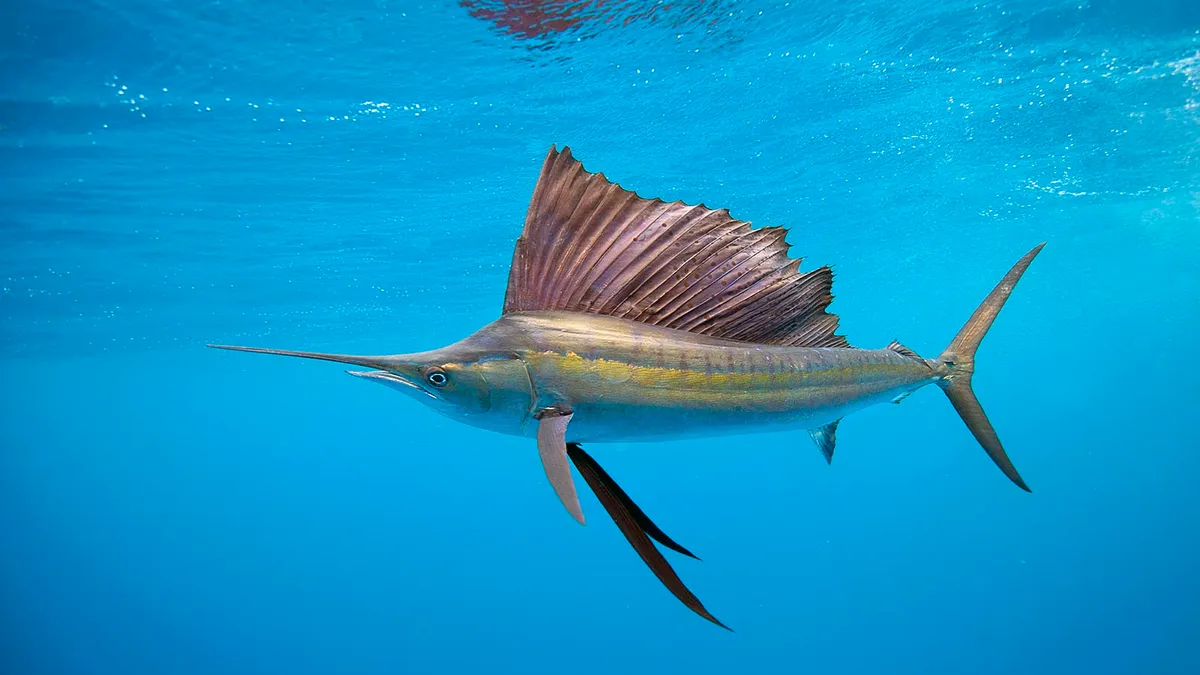Sailfish are popular in recreational fishing (catch and release) but have little value in the commercial fishing industry and cannot be fished commercially in the Atlantic Ocean. Sport fisheries account for the sailfish’s highest catch rates, particularly in the Eastern Pacific Ocean where the species can be found near Central American coasts. What are Ideal Water Conditions for Sailfish?
Introduction:
Sailfish are magnificent creatures known for their incredible speed and agility in the ocean. Belonging to the family Istiophoridae, they are characterized by their long, slender bodies and distinctive sail-like dorsal fins. These apex predators are highly sought after by anglers for their acrobatic displays when hooked and their challenging fighting abilities. Found in tropical and subtropical waters around the world, sailfish are a prized species among sport fishermen and a key component of marine ecosystems.
Understanding the ideal water conditions for sailfish is crucial for various reasons. Firstly, it provides valuable insights into their habitat preferences and distribution patterns, aiding in conservation efforts and management strategies. By identifying the specific environmental factors that influence sailfish behavior and habitat selection, researchers and conservationists can better protect critical areas and mitigate potential threats.
Furthermore, knowledge of optimal water conditions is essential for sustainable fisheries management, ensuring that sailfish populations are not overexploited. Additionally, understanding how sailfish respond to changing environmental conditions can help predict their movements and improve recreational fishing opportunities. Overall, studying the ideal water conditions for sailfish is essential for both their conservation and the enjoyment of future generations.
What is the difference between Sailfish and Swordfish:
Sailfish and swordfish are both large, predatory fish found in the ocean, but they belong to different taxonomic families and exhibit distinct physical characteristics. Sailfish, belonging to the family Istiophoridae, are known for their elongated bodies, prominent dorsal fin resembling a sail, and vibrant blue and silver coloration. In contrast, swordfish, members of the family Xiphiidae, are characterized by their broad, flattened bills resembling a sword, lack of pelvic fins, and typically darker coloration.
What are Ideal Water Conditions for Sailfish
The ideal water conditions for sailfish typically include warm temperatures ranging between 70°F (21°C) and 85°F (29°C), providing optimal conditions for their physiological function and metabolic activity. Additionally, sailfish thrive in waters with adequate dissolved oxygen levels, which are crucial for their respiration and overall health. They are often found in areas with moderate to high salinity levels, although they can tolerate a wide range of salinity variations.
Sailfish are also attracted to oceanographic features such as thermoclines and currents, which concentrate prey and enhance feeding opportunities. Overall, understanding and identifying these ideal water conditions are essential for anglers and researchers seeking to locate and conserve sailfish populations in their natural habitat.
Ideal Habitats for Sailfish
Sailfish are predominantly found in warm tropical and subtropical waters around the world, inhabiting both coastal and offshore areas. Their natural range extends across the Atlantic, Pacific, and Indian Oceans, encompassing regions such as the Caribbean Sea, Gulf of Mexico, Mediterranean Sea, and the waters off the coasts of Africa, Asia, and Central and South America. Within these expansive ranges, sailfish populations may exhibit seasonal migrations in response to changes in water temperature, prey availability, and other environmental factors.
Sailfish display a preference for specific habitats within their range, often favoring areas with abundant prey resources and suitable environmental conditions. Coastal areas with steep drop-offs, underwater structures like reefs and seamounts, and convergence zones where ocean currents meet are commonly frequented by sailfish.
These habitats provide ample opportunities for hunting and feeding on various prey species, including smaller fish, squid, and crustaceans. Additionally, sailfish are often associated with offshore pelagic environments, where they can roam vast expanses of open water in search of prey. These habitats offer sailfish the space and freedom to utilize their exceptional speed and agility while hunting. Overall, sailfish tend to inhabit dynamic oceanic environments that support their predatory lifestyle and provide opportunities for efficient foraging.
Ideal Salinity Levels for Sailfish
What is the average size of a sailfish?
The average size of a sailfish typically ranges between 6 to 11 feet (1.8 to 3.4 meters) in length and weighs around 120 to 220 pounds (54 to 100 kilograms). However, larger individuals have been recorded, with some reaching lengths of up to 14 feet (4.3 meters) and weights exceeding 200 pounds (90 kilograms).
Where can sailfish be found?
Sailfish are predominantly found in warm oceanic waters around the world, inhabiting both coastal and offshore areas. They are commonly found in tropical and subtropical regions of the Atlantic, Pacific, and Indian Oceans, including areas such as the Caribbean Sea, Gulf of Mexico, and waters off the coasts of Africa, Asia, and Central and South America.
What are some popular techniques for catching sailfish?
Some popular techniques for catching sailfish include trolling with rigged baits or lures, live bait fishing using techniques such as kite fishing or slow trolling, and using artificial lures such as teasers and dredges to attract and hook sailfish. Additionally, drift fishing with live bait or dead bait can also be effective, particularly in areas with strong currents or over underwater structures where sailfish are known to congregate. Anglers often use specialized tackle such as heavy-duty rods, reels with high-capacity spools, and circle hooks to target sailfish effectively while minimizing harm to the fish during catch-and-release practices.
How fast can sailfish swim?

